Did you know that more than half of all American students will take out a student loan in order to complete their degree? It’s true. And it’s also one of the reasons we wrote this student loan guide.
anchor
Introduction to Student Loans
No matter where you are in your student loan journey — from exploring if they are the best option for you to finance your education, to figuring out which repayment plan is ideal for you — there’s information in this student loan guide to help you. View this as your go-to guide for learning the ins and outs of student loans.
While each section of this guide can be read by itself to get the most of it, read it all the way through at least once, then use it as a reference tool.
Interested in a specific topic? You can easily navigate to specific sections using the provided links.
anchor
What are Student Loans?
A student loan is money you borrow to pay for your education that you must pay back with interest. Money borrowed for education from the US government is called a federal student loan. Whereas money borrowed from a private institution, such as a bank, credit union, or state agency is called a private student loan.
Overview
Having a solid understanding of what a student loan is and what will be required of you when you take out a student loan is a major step in determining if student loans are a viable option for you to finance your education. While this information is helpful to understand before you take out a student loan, no matter where you are on your student loan journey this information will help you become familiar with common student loan phrases and terms.
Principal
The principal of your student loan is the total amount of money you borrowed to pay for your education. For example: if you borrowed $25,000, then the principal of your loan will be $25,000.
Interest
Student loan interest is the amount you have to pay to borrow the principal amount. There are different types of student loan interest. Keep in mind that the interest on the loan is determined by the loan type and loan servicer.
A student loan interest rate is either a:
- Fixed interest rate. This rate is set at the time you accept the loan and this rate won’t change over the life of the loan. There aren’t too many surprises on fixed interest rate loans. The interest never changes, and your repayment plan will be very consistent. The way you can change the interest rate of your student loan is by refinancing the loan to an, ideally, lower interest rate.
- Variable interest rate. Variable rates will fluctuate over the life of the loan based on market rates. What do we mean by this? Depending on your loan servicer, the interest on the student loan will be tied to an index rate like LIBOR (the London Interbank Offered Rate) or prime rate, to name a few. While the starting interest rate may be lower when compared to a fixed interest rate, be prepared to have the rate and monthly payment change over the life of the loan. Sometimes it goes up, and other times it goes down. It all depends on the market rate the loan is tied to. Side note: variable interest rates are not offered by Federal Student Loans.
Student loans aren’t free
Unfortunately, student loans are not free. Not only do you need to repay the principal amount, you need to repay the student loan interest. Student loans accrue interest over time. This means you will have to pay more than what you initially borrowed (the principal amount).
While you may be able to defer interest payments on some types of loans while you are in school or starting your career, the loan interest may still accrue during those times.
To gain a better understanding of how student loan interest can accrue, let’s consider this example.
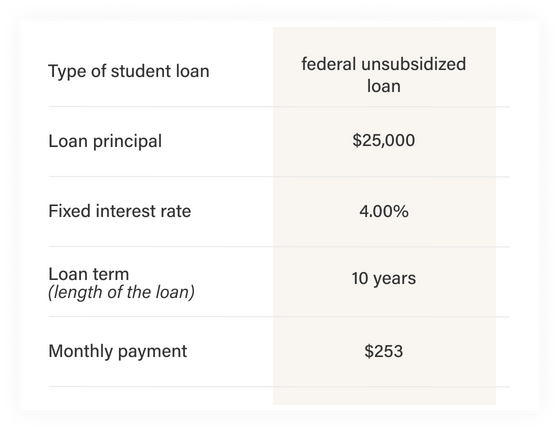
Based on these numbers, and the assumptions that you (1) will only make the minimum monthly payment over the 10 years, and (2) will not defer making payments on the loan, the total lifetime cost of this loan will be $30,374. This means the total amount of interest you will pay is $5,374.
anchor
Alternative/Additional Funding for Higher Education
While student loans are a common way to finance education, they are not the only way. The total amount of money you receive in order to pay for your higher education is called your financial aid. Financial aid may be available in the form of federal or private student loans, as well as free aid, which includes scholarships, grants, or work-study programs. All of the free aid you receive plus any loans (federal or private) that you take out is considered your financial aid.
This section is written to help you figure out alternative methods and strategies for financing your education.
Scholarships
Scholarships are financial aid awards given to students who meet specific criteria determined by the scholarship-giver. Often merit or needs-based, the best part about scholarships is they do not have to be repaid.
When looking for scholarships, cast a wide net. You’d be surprised at the types of scholarships you’ll be able to find. Are you part of any clubs or organizations that offer scholarships to their members? Do you have any unusual hobbies or talents? Have you participated in sports or service projects?
If you’re still having a hard time figuring out where to begin, a good place to start is by asking your school counselor or by working with your school’s financial aid officer. You can also consider searching for scholarships online.
Helpful websites to search for scholarships on:
- Scholarships.com
- Fastweb.com
- CollegeBoard.org
- FinAid.org
Grants
Unlike student loans, grants generally don’t have to be repaid. Grants can come from your state government, the federal government, your college/trade school, or a private/nonprofit organization. By doing a little research and applying for the grants you qualify for, you could potentially lower the total amount from student loans that you need to borrow or eliminate the need to borrow altogether.
Part Time Work
Check to see what other options your school offers to help students financially. You can work with the financial aid office to see if they offer university grants, scholarships to students who hold on-campus jobs, or if they have a tuition payment plan.
While it can be tempting to complete your degree as quickly as possible, it may be worth considering reducing the number of credits that you take each semester so that you have enough time to work part/full time if this arrangement allows you to avoid student loans altogether. You can even take a semester off to work full time — a popular option for college students during the summer.
How to save on your education
A large portion of your college expenses will be your living expenses. By finding ways to reduce these expenses upfront, you may be able to avoid taking out a student loan or reduce the amount of money you need to borrow. Below are ideas on how to cut your living and academic expenses while you are in school.
Reduce your rent
- Instead of living on your own, consider having roommates. This doesn’t necessarily mean you have to share your room either. You can still save thousands of dollars per year if you have your own room.
- Consider the benefits of living either off-campus or on-campus. There may be cost-saving options in both scenarios, depending on your personal situation. When living on campus, your total rent costs could be higher. But remember, your on-campus rent includes all of your utilities, such as water, electricity, and internet. Additionally, living on campus may be more convenient (hello short commute!), which could reduce any additional travel expenses to get to and from class. Alternatively, living off-campus may provide you with lower rent costs, but be sure to look at all of your off-campus costs, including your utilities and internet, as those expenses generally won’t be in your rent cost. If living off-campus is the best option for you, look for places that are close to public transportation, or are within walking distance from campus.
- If you’re able to, consider living at home or with a relative or family friend. Even if it’s a short commute to campus, you might still be able to significantly reduce your living expenses this way.
Reduce your academic expenses
- Rent your textbooks, instead of buying them. For a fraction of the price—especially for the really expensive ones—you can rent a textbook for a semester.
- Textbooks are full of information that may be required for a specific class, but what do you do with them after the course ends? Consider selling them! You can recoup some of the money you paid for it, and, there’s always the internet to help refresh your memory after graduation.
- You don’t have to buy new textbooks. If you’re able to find used textbooks at the campus bookstore, or online, go for it! You might also be able to buy textbooks from friends who completed the course last semester.
- Compare prices between campus bookstores, off-campus bookstores, and online. Typically, for more common classes, textbooks are the same across multiple universities, so chances are, you might be able to find a lower price for textbook by shopping outside the campus bookstore.
anchor
Types of Student Loans
There are various types of student loans available to help pay for your college education. They are generally grouped into two main categories, federal student loans and private student loans.
First, let’s cover federal student loans. Loans borrowed from the U.S. government are federal student loans. Federal student loans include the following types: Direct Subsidized (“Subsidized Stafford”), Direct Unsubsidized (“Unsubsidized Stafford”), Direct PLUS, and Federal Perkins (retired in 2017).
Direct Subsidized (“Subsidized Stafford”)
Direct subsidized loans (also referred to as “Subsidized Stafford” loans) are available to undergraduate students who have demonstrated financial need. The annual limit for subsidized loans differs depending on where you are in your education journey (first year of your program versus your fourth year).
The aggregate loan limit for dependent students, except students whose parents are unable to obtain PLUS Loans, is $31,000. Of this amount, no more than $23,000 of this may be in subsidized loans.
The aggregate limit for independent undergraduate students, and dependent undergraduate students whose parents are unable to obtain PLUS loans, is $57,500. Similarly, no more than $23,000 of this amount may be in subsidized loans.
Interest on Direct Subsidized loans is paid by the U.S. Department of Education while you’re in school at least half-time, as well as for the first six months after you graduate from school. This six month period is also referred to as the grace period.
Interest rates for Direct Subsidized loans are fixed over the life of the loan. The interest rate for loans disbursed on or after July 1, 2020 to July 1, 2021 is 2.75%.
Repayment of Direct Subsidized loans begins six months after you graduate, drop below half-time enrollment, or leave school.
Direct Unsubsidized (“Unsubsidized Stafford”)
Direct unsubsidized loans (also referred to as “Unsubsidized Stafford” loans) are available to undergraduate and graduate students. Recipients of Direct Unsubsidized loans are not required to demonstrate financial need. The annual limit for unsubsidized loans differs depending on where you are in your education journey (first year of your program versus your fourth year). The aggregate loan limit for dependent students, except students whose parents are unable to obtain PLUS Loans, is $31,000. Of this amount, no more than $23,000 of this may be in subsidized loans. The aggregate limit for independent undergraduate students is $57,500. Similarly, no more than $23,000 of this amount may be in subsidized loans.
Unlike Direct Subsidized loans, interest on Direct Unsubsidized loans is not paid by the U.S. Department of Education while you’re in school. Interest on Direct Unsubsidized loans is the responsibility of the student both while in school and after graduating. Remember that failing to pay interest on your Direct Unsubsidized loan while in school causes the interest to accrue and then be capitalized (meaning that the accrued interest will be added to the original principal amount of the loan).
Interest rates for Direct Unsubsidized loans are fixed over the life of the loan. The interest rate for loans disbursed on or after July 1, 2020 to July 1, 2021 is 2.75% for undergraduates and 4.30% for graduate or professional borrowers.
Repayment of Direct Unsubsidized loans begins six months after you graduate, drop below half-time enrollment, or leave school.
Direct PLUS Loans
Direct PLUS loans are available to graduate and professional degree students as well as parents of dependent undergraduate students. Direct PLUS loans are often referred to as a grad PLUS loan when made to a graduate or professional student and a PLUS loan when made to a parent. Unlike the Direct Subsidized and Direct Unsubsidized loans, you cannot have an adverse credit history in order to obtain a Direct Plus loan, and a credit check will be conducted.
The maximum amount a student or parent can borrow for a Direct Plus loan is the cost of attendance less any other financial assistance that is received. The cost of attendance is determined by the school.
Interest is the responsibility of the student or parent. Remember that failing to pay interest on your Direct PLUS loan at any time that it is required causes the interest to accrue and then be capitalized (meaning that the accrued interest will be added to the original principal amount of the loan).
Interest rates for Direct PLUS loans are fixed over the life of the loan. The interest rate for loans disbursed on or after July 1, 2020 to July 1, 2021 is 5.30%.
Repayment of Direct PLUS loans begins six months after you graduate, drop below half-time enrollment, or leave school.
Federal Perkins Loan
The Federal Perkins Loan program (or “Perkins Loan”) was available to undergraduate and graduate students with exceptional financial need. The Perkins Loan program has since ended, and as of September 30, 2017 schools are no longer allowed to make new Federal Perkins loans to students.
Repayment of Perkins loans began nine months after you graduate, drop below half-time enrollment, or leave school.
Next, let’s cover private student loans. Loans from a private institution, such as a bank, credit union, other state agency, or financial institution are considered private student loans.
Private Student Loans
Private student loans are not issued by the government, and therefore, the terms, eligibility requirements, and borrower benefits can differ across the various providers. Private student loans are typically issued by banks, credit unions, or state agencies.
- Eligibility Requirements. One of the biggest differentiators between federal student loans and private student loans are the eligibility requirements. Oftentimes, private student loan providers will require that the applicant have a well-established credit history in order to apply for a loan. While many private student loan providers will require an established credit history, if an applicant does not have a sufficient credit history, loan providers will allow the applicant to have a co-signer. A co-signer could be a parent or guardian with a more established credit history who chooses to sign onto the loan with the student.
It’s important to remember that the eligibility rules differ depending on the provider. So, while one lender may require a sufficient credit history, the next lender may not. It just depends. Some other eligibility requirements to look out for may include: education, age, and citizenship requirements.
- Interest Rate. Federal student loans by their nature have a fixed rate, whereas private student loans can have fixed or variable rates, depending on the lender. With private student loans, the credit history of you or your co-signer will likely be a determining factor in what interest rate you get on your loan. If you or your co-signer have an exceptional credit score and history, the better your interest rate could be.
- Repayment. Private student loan providers are generally less flexible when it comes to loan repayment options. Private student loan repayment options are discussed in greater detail within the Private Student Loans Repayment section.
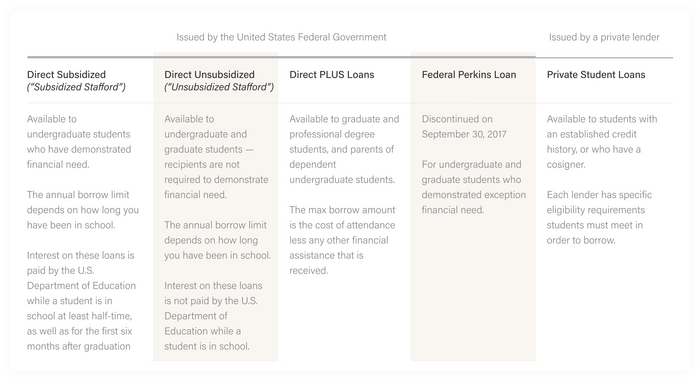
anchor
How to Apply for Student Loans
The application process varies depending on the type of loan you are applying for. In this section we cover the basics of applying for each of the different student loan types.
Applying for federal student loans - FAFSA
To apply for federal student loans, you will need to complete a Free Application for Federal Student Aid (“FAFSA”) form each year that you are in school. The FAFSA is a form provided by the US government that helps determine how much money you are eligible to receive in student aid from the government. State schools and private colleges and universities use the information provided by you in this application to determine your financial aid. The FAFSA can be completed online, and there is no cost to complete or submit the FAFSA. Navigate to fafsa.gov to complete an application.
Applying for Direct PLUS loans
Applications for Direct PLUS loans are submitted via the Federal Student Aid website. Similarly, if you are a parent applying for a Parent PLUS loan, the application can also be found on the Federal Student Aid website.
Remember, when applying for a Direct PLUS loan, a credit check is performed. If you happen to have a security freeze on your file, ensure that any freeze is removed prior to applying for a Direct PLUS loan. Applications submitted with security freezes will not be accepted.
Applying for private student loans
As private student loans are made by a variety of different lenders, there is no one size fits all application like there is for federal student loans. To apply for private student loans, consider checking first with your school’s student aid website. Sometimes, schools will post recommended private student loan lenders and other useful resources on the website. While each application may differ from lender to lender, gather all of the important information (for both you and your co-signer, if applicable) to make applying for the loan simple. Generally, you’ll need the following personal information:
- social security numbers
- addresses
- birthdates
- employment and income information (pay stub copies)
- most recent tax returns
- any mortgage or asset details
You’ll also need some information about your school:
- the school’s name
- address of the school
- how much it will cost to attend
- how much you will need to take out in a loan
- when you expect to graduate
Deadlines
To apply for federal student aid, file your FAFSA application as early as possible. The FAFSA opens on October 1 of each year for the following school year. Example: On October 1, 2021, the FAFSA will open for students for the 2022-23 school year.
The deadline for applying for federal aid is June 30th of the year after a student needs aid. Using the previous example, students will need to submit a FAFSA application by June 30, 2023 in order to meet the application deadline for the 2022-23 year.
Filing your FAFSA as early as possible is important. Don’t wait until you’ve been accepted to a college or university to start applying. It’s important to remember that states and colleges can set their own FAFSA deadlines. You can find these deadlines on your school’s website.
Remember that if you’re applying for private student loans, deadlines will differ depending on the lender. Check with each lender to determine the application deadlines.
Your school’s student aid office
While the application process can feel cumbersome, it’s helpful to leverage the resources available at your school. The student aid or financial aid office of each of the colleges or universities you are applying for can be a valuable resource in the application process. Review the website of your school for information on how to contact the student aid office as well as additional resources about deadlines and other important information when it comes to applying.
anchor
The Approval Process
Once you’ve applied for a student loan, there are still a few more steps within the financial aid process. Remember, financial aid is the total amount of money you receive in the form of free aid (scholarships, grants, work-study programs) plus loans. In this section we outline the final steps of the student loan process (as outlined by the graphic below).
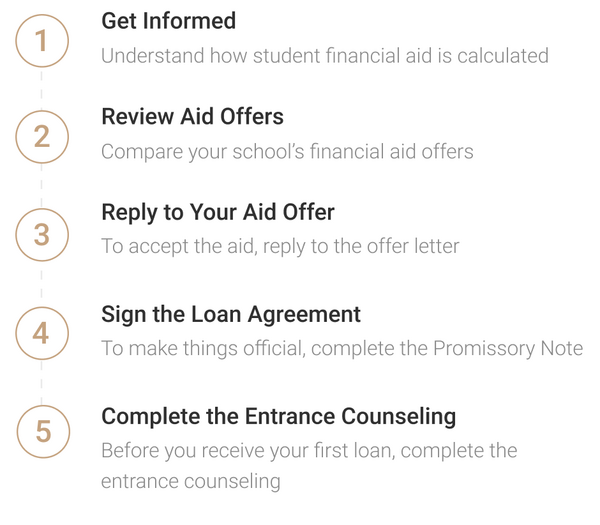
Timeline
After completing the financial aid application process, your school’s financial aid office will send you a financial aid offer. In this offer, the school will ask you to indicate to them what of the aid you want to accept. Remember that it is important to accept free aid first. Free aid is anything that you are not required to pay back such as scholarships or grants. Then, you will want to accept any earned money such as a work study program. Finally, you will want to look at loans. Loans should be explored in the following order:
- Federal loans
- Loans from your state or local college
- Private loans
Promissory notes
One of the final steps you’ll take before receiving student loan money is signing a promissory note. A promissory note is an important document that explains all of the terms of the loan. A few key pieces of information in this document that you’ll need to review before signing include:
- Disbursement date. This is when you will receive the funds and when the interest will start accruing on the loan.
- Amount borrowed. This is also known as the student loan principal. We will cover more about the principal below.
- Interest rate. This is the amount you have to pay in order to borrow the money.
- How interest accrues. This part of the document will tell you how the interest on the loan will accumulate over time. Typically student loan interest accrues daily or monthly.
- How interest capitalizes. This is a fancy way of talking about when the accrued interest will be added to your principal balance. This is important to note because once the accrued interest is added to your balance, interest will start accruing on the new amount. Think of it as interest growing on interest.
- First payment date. This is when you need to make the first loan payment.
- Payment schedule. This part of the promissory note will tell you how many payments you have to make to repay the principal and interest of the loan. Included in the section will be how much your monthly payment will be.
anchor
Repayment Options
Repayment options will likely differ depending on whether you have federal or private student loans. There are two types of categories for federal student loan repayment plans: traditional plans and income-driven plans. Your situation after graduation and the type of federal student loan you have will impact which type of repayment plan you choose.
Traditional Repayment Plans
- Standard repayment plan
- Graduated repayment plan
- Extended repayment plan
Income-driven Repayment Plans
The following repayment plans base your monthly payment on your income and family size. Many of these repayment plan options are only available to those who meet specific requirements, while some are available to anyone with a qualifying federal student loan.
- Revised Pay As You Earn (REPAYE)
- Pay As You Earn (PAYE)
- Income-based repayment (IBR)
- Income-contingent repayment (ICR)
- Income-sensitive repayment (ISR)
Private student loan providers are generally less flexible when it comes to loan repayment options, but some of the repayment options will look similar to the Traditional Repayment Plans offered to federal loan holders. These options may include:
- Immediate repayment plan
- Graduated repayment plan
- Interest only repayment plan
- In-school deferment
Below, we will cover each of the repayment plans in greater detail.
Standard repayment plan
This is the plan for you if you’re looking for the quickest way to pay off your student loans. The standard repayment plan includes fixed monthly payments over the course of 10 years for non-consolidated loans. This is one of the shortest repayment plans offered by the federal government. Because of the short repayment period, your minimum monthly loan payments will be slightly higher when compared to other repayment plans.
You also have the option to select this repayment plan if you have consolidated multiple federal student loans into a single loan. However, instead of repaying a single loan over 10 years, your repayment period for the consolidated loan can be between 10 to 30 years, depending on the total amount of the debt being consolidated.
The standard repayment plan is ideal for those who are looking to repay their loans as quickly as possible, or for those who have a high-income job and don’t want their monthly payment to be income-driven. Often, if you have a high-income job, by selecting this plan you’ll have a lower monthly payment compared to an income-driven repayment plan.
If you’re planning to seek Public Service Loan Forgiveness (PSLF), this is not the plan for you. You often will need to work in the public service sector for 10 or more years before your loans can be forgiven, so we’d recommend considering selecting an income-driven repayment plan instead.
One of the downsides of this plan is if you experience a drop in your income, your payments will remain the same, which in some cases can cause financial hardship.
Graduated repayment plan
Similar to the standard repayment plan, the repayment period for this type of plan is 10 years for a non-consolidated loan. The difference is, instead of a fixed monthly payment for those 10 years, the graduated repayment plan features lower initial monthly payments that increase every two years.
The graduated repayment plan is ideal for those who enter their career with a lower starting income but expect their income to grow throughout the 10 year repayment period.
For those who consolidated their federal student loans, your repayment period will depend on your total amount of debt and can be up to 30 years.
Like the standard repayment plan, this is not an ideal repayment plan for those who are planning to seek PSLF.
Keep in mind that if you select this plan over the standard repayment plan you’ll pay slightly more in interest since you’ll accrue more interest on the student loan when your minimum monthly payments are lower in the beginning.
Extended repayment plan
The extended repayment plan is offered to students with over $30,000 in federal student loans. This repayment plan extends the repayment period for your loan from 10 years to up to 25 years. With the extended monthly repayment schedule, your minimum monthly payments will generally be lower than those in the standard or graduated plans.
A word of caution for selecting this plan: if you’re seeking lower payments over a longer period of time you’re often better off selecting an income-driven repayment plan since these types of plans provide forgiveness on the remaining balance of your loan after 20 to 25 years. While you will still need to pay taxes on the forgiven amount, you often end up paying less overall when compared to the extended repayment plan.
With the longer repayment period, you’ll pay more in loan interest, and for this loan, there isn’t a forgiveness option.
Revised Pay As You Earn (REPAYE)
Your monthly payment for your loans under REPAYE is set at 10% of your discretionary monthly income. For this program, your discretionary income is the difference between your annual income and 150% of the poverty guideline for your family size and the state where you live.
How to calculate your discretionary income
To calculate your discretionary income you’ll need to determine the poverty guideline for your family size and the state you live in using the U.S. Department of Health & Human Services poverty guidelines chart. Keep in mind this chart is updated annually. After determining the poverty guideline for you, the rest is simple math to figure out the rest.
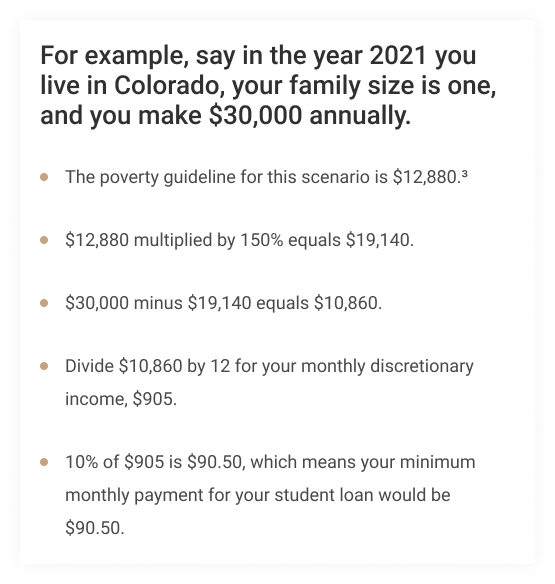
When you select this plan it is very important to update your family size and income annually. If you don’t, you can be removed from the plan which could make your minimum monthly payment dramatically increase.
Depending on your income and family size your minimum monthly payment under this plan could be higher than what you’d need to pay under one of the traditional repayment plans. Take the time to compare each plan to see what makes the most sense for you.
If all of your student loan was used towards your undergraduate studies your repayment period will be 20 years for this plan. If any of your loan was used towards your graduate studies your repayment period will be 25 years.
Pay As You Earn (PAYE)
Like the REPAYE plan, this plan sets your monthly payment at 10% of your monthly discretionary income (see REPAYE section for how to calculate this number). Unlike the REPAYE plan, this plan caps your monthly payment at the standard repayment plan level, which means you’ll never pay more than you would on a standard plan.
While this plan is often ideal for those with a high student loan balance, you must meet specific qualifications to qualify for this plan: you must have received your first federal student loan on or after October 1, 2007, and then received an additional student loan on or after October 1, 2011.
Income-based repayment (IBR)
The income-based repayment plan largely depends on when you first borrowed federal student loan money:
If you first borrowed on or after July 1, 2014 your minimum monthly payment will be 10% of your discretionary income over a 20 year repayment period
If you first borrowed before July 1, 2014 your minimum monthly payment will be 15% of your discretionary income over a 25 year repayment period
This plan can be ideal for new federal student loan borrowers with a high balance and are looking for lower monthly payments. If you don’t qualify as a new borrower, while the minimum monthly payments being set to 15% of your discretionary income means you will pay more per month than under the PAYE plan, the total amount of interest you pay over time may be lower under this plan.
See the section under the REPAYE section for directions on how to calculate your discretionary income.
Income-contingent repayment (ICR)
This plan sets your minimum monthly payment to be the lesser of 20% of your discretionary income or the amount you would pay under a standard repayment plan with a 12-year repayment term, over a 25-year repayment term.
Take note! The ICR plan uses a different definition of discretionary income than the other income-driven repayment plans. Your discretionary income is the difference between your actual income and 100% of the poverty guideline for your state and family size.
How to calculate your discretionary income for the ICR plan
To calculate your discretionary income for this plan you’ll need to determine the poverty guideline for your family size and the state you live in using the U.S. Department of Health & Human Services poverty guidelines chart. Keep in mind this chart is updated annually. After determining the poverty guideline for you, the rest is simple math to figure out the rest.
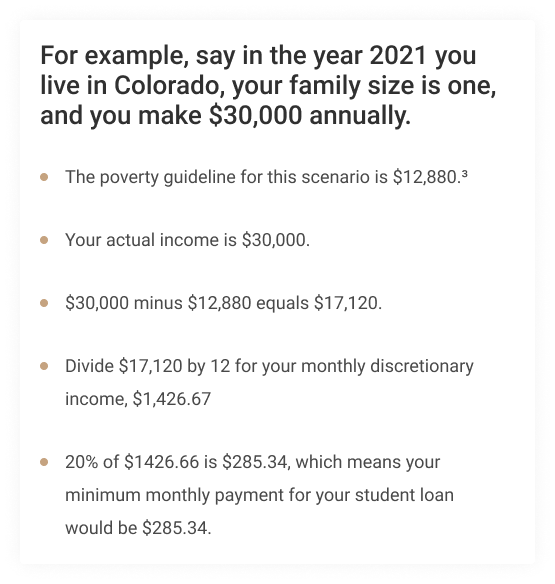
This plan is typically good for those who are looking for a lower monthly payment and a longer repayment period than what they would get under the standard repayment plans. This is also the only income-driven repayment plan option available to parents of PLUS loan borrowers — they must consolidate their LUS loans into a direct loan to qualify.
Income-sensitive repayment (ISR)
This is the only income-driven repayment plan that is available for loans from the Federal Family Education Loan (FFEL) program. If you’ve never heard of the FFEL program it’s probably because it was discontinued in 2010.
Payments for this plan are determined by your lender and based on your annual income. Your minimum monthly payments under this plan may change every year and are typically between 4% and 25% of your gross income. The repayment period for this plan is 10 years.
Keep in mind that you can also only qualify for this repayment option if your monthly payments exceed 20% of your income.
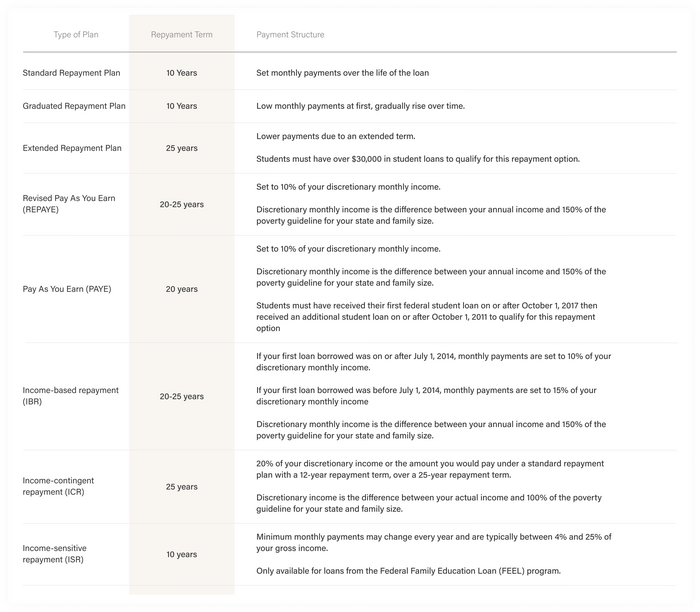
anchor
Consolidating and Refinancing Loans
In this section we have highlighted two potential opportunities for you to consider when looking for ways to reduce your student loan debt. Direct Consolidation loans and refinancing provide you with potential ways to lower your interest rate, and therefore reduce the amount of money you are paying over the life of the loan. Direct Consolidation loans are available to students with federal loans, while refinancing is available to students with either federal or private student loans.
Direct Consolidation Loans
Direct Consolidation loans allow you to take multiple student loans and combine them into one loan, with one fixed interest rate. The interest rate for the Direct Consolidation loan is determined using the average rate of the loans to be consolidated.
There is no cost to apply for or obtain a Direct Consolidation loan. Direct Consolidation loans provide simplicity when managing the various payments on student loans as it turns your many loan payments into one monthly payment. While this is a benefit of consolidation, consolidation could also cause you to lose certain benefits. It’s important to consider what benefits you will be potentially gaining or losing prior to choosing to consolidate.
Private student loans cannot be consolidated but can be refinanced.
Refinancing
Refinancing student loans is the process of replacing your current student loans with a new loan from a new lender. The old loans are paid off by the new lender, and the new lender provides you with a new loan, ideally with a lower interest rate.
Depending on the type of student loan you have, you may have certain loan forgiveness or deferment benefits that you may have to give up if you decide to refinance. So while refinancing for a better interest rate is great, it’s important to know what you’re giving up in order to get that better rate.
Individuals with private or federal student loans can refinance. The qualifications for refinancing student loans differ depending on the loan provider, but have similar qualifications to those you may see when applying for a private student loan. Student loans can be refinanced at any time and as often as you want. There are no fees or costs associated with refinancing your student loans, or applying to refinance.

anchor
Paying Off Your Student Loans Early
Should you pay off your student loans early?
The quickest way to pay off your student loan is to make additional payments to the principal of the loan. The smaller the principal amount of your loan, the smaller the amount of interest that will accrue, making it faster to pay off the loan.
It’s important that you take into consideration how an extra payment on your loan will affect your overall monthly budget. If you do not have a budget, a good starting place is using the 50/30/20 strategy. You can use the information from your budget to help you avoid a situation where if you make an additional payment you would be unable to pay other bills or living expenses.
How to pay off your student loans early
If you can make additional payments on your loan it is crucial to take the time to see how your student loan servicer will apply the additional payment. Often student loan servicers will view an additional payment as a “paid ahead” amount for future payments. For example, if your student loan payment is $298 per month and you make an additional payment of $100, your next monthly payment will be $198.
To change this, you need to contact your student loan servicer to make sure your additional payment is applied to the principal of the loan. After receiving confirmation that they will apply your additional payment in this way, you still need to carefully examine your student loan statements. Do this to ensure your student loan servicer is actually following your request. This may sound over the top and time-consuming but has the potential to save you a lot of money and headaches down the road.
If you’re currently still in school, another possibility to help decrease the principal amount of your loan before you enter into the repayment period is making payments while you are in school. Again, any amount that you’re able to pay towards the principal of the loan before interest begins accruing, or before you enter into the repayment period, will help you decrease the total amount of interest you need to pay.
anchor
Tax Benefits
There are at least some benefits to your student loans. You may be entitled to a tax deduction on the qualified student loan interest that you have paid, as long as your income doesn’t exceed certain limits. Contact your lender for the Form 1098E, the required tax form, so you can get a tax deduction for the interest you paid on your student loans.
anchor
Student Loan Forgiveness
If you are interested in a public service career, check to see if your student loans can be partially or fully forgiven. Often, graduates who work within the public sector in government organizations, non-profits, law enforcement, teaching, or the military may qualify to have their student loans forgiven partially or fully.
There is a list of specific requirements you will have to meet in order to have your student loans either partially or fully forgiven. Often you will be required to make payments on your student loans over a set amount of time, and to verify you have worked in the public service sector for a specific number of years (and are currently still working in that field), among other requirements. There are specific, and extensive application processes for applying for student loan forgiveness For more information on student loan forgiveness, to see if you may qualify, and to learn how to apply, visit StudentAid.gov.
Sources
1. https://aspe.hhs.gov/2021-poverty-guidelines/
2. https://www.federalreserve.gov/publications/2019-economic-well-being-of-us-households-in-2018-student-loans-and-other-education-debt.htm
This blog is not intended to provide any tax, legal, financial planning, insurance, accounting, investment, or any other kind of professional advice or services. To make sure that any information or suggestions in this blog fit your particular circumstances, you should consult with an appropriate tax or legal professional before taking action based on any suggestions or information that we provide.
